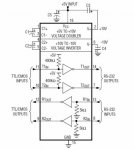John Chris
Senior Member
Hi,
I am using the 18X to drive a MAX232A serial transciever. As I have things set up, however, the picaxe does not like the backwards capacitors (-C --> pin 6, +C --> 0V as well as +C --> pin 2, -C to 5V)
I can not clear the memory of the microcontroller when these capacitors are in place. Why might this be?
In the MAX232 datasheet they suggest 5 capacitors, an additional capacitor (proper polarity) arrangement between supply and ground, whereas this is not shown on pg. 43 of PICAXE manual 3. I'm assuming this is trivial
Is there a reason it is referred to as 0V and not GND? Is this standard notation for circuits involving +/- signals ?
Thanks
I am using the 18X to drive a MAX232A serial transciever. As I have things set up, however, the picaxe does not like the backwards capacitors (-C --> pin 6, +C --> 0V as well as +C --> pin 2, -C to 5V)
I can not clear the memory of the microcontroller when these capacitors are in place. Why might this be?
In the MAX232 datasheet they suggest 5 capacitors, an additional capacitor (proper polarity) arrangement between supply and ground, whereas this is not shown on pg. 43 of PICAXE manual 3. I'm assuming this is trivial
Is there a reason it is referred to as 0V and not GND? Is this standard notation for circuits involving +/- signals ?
Thanks
Last edited by a moderator:


